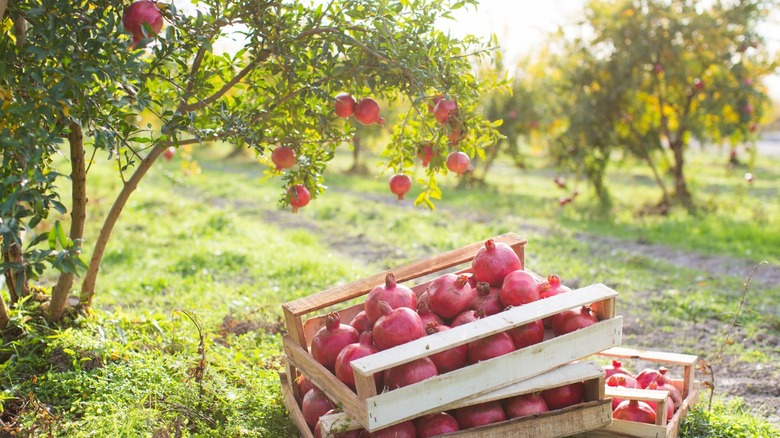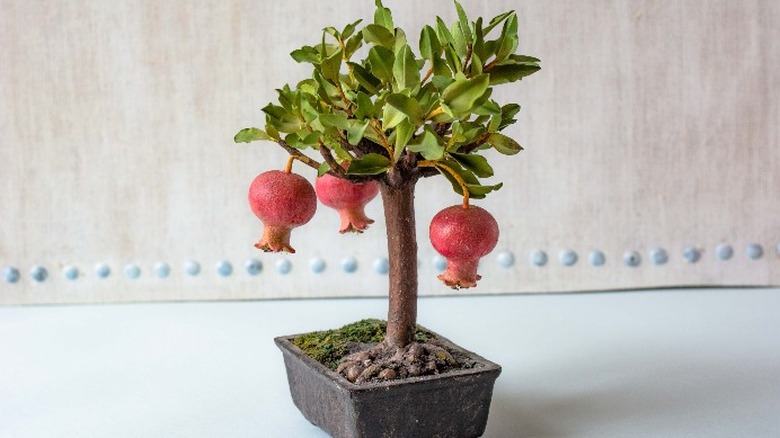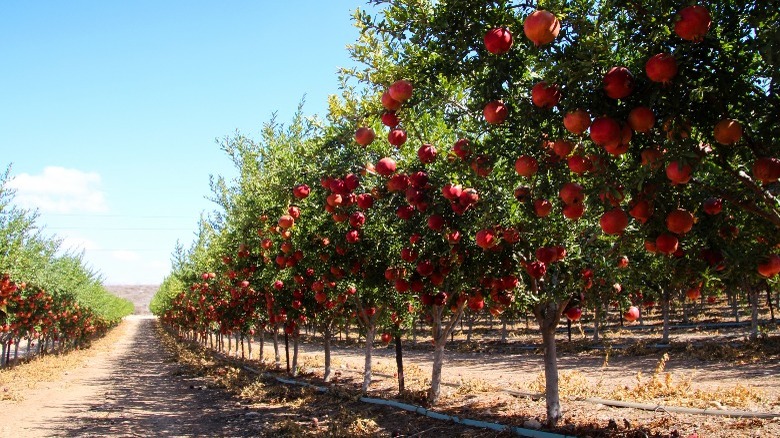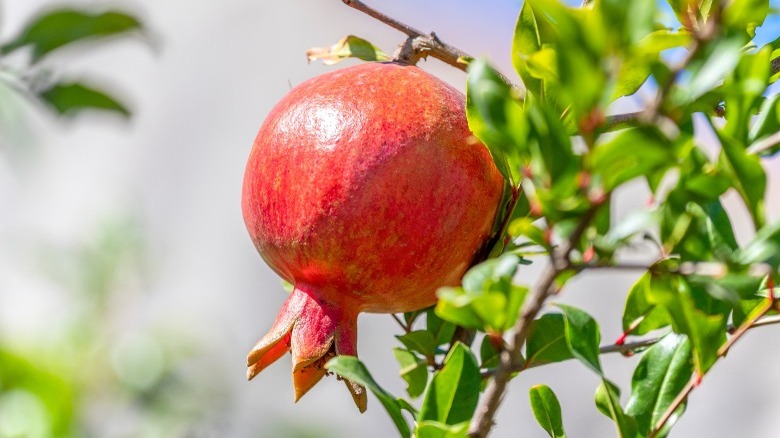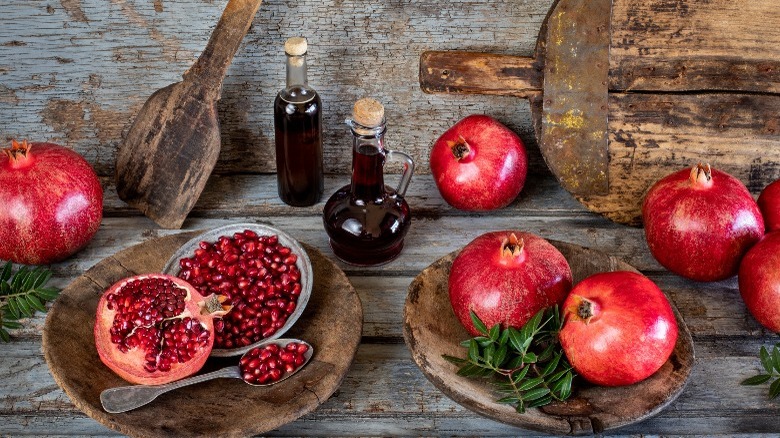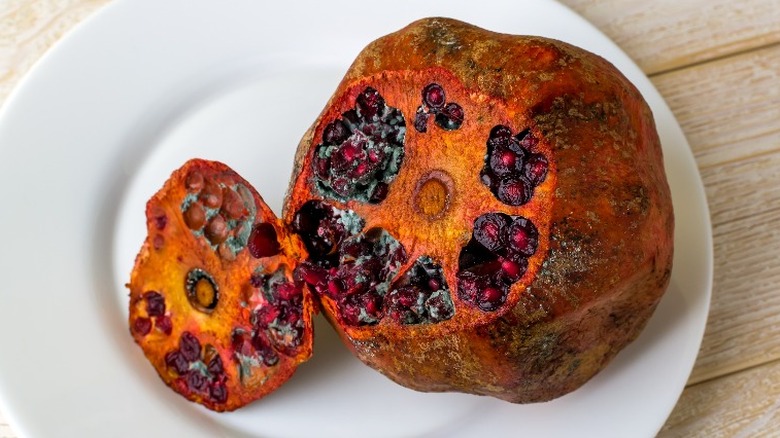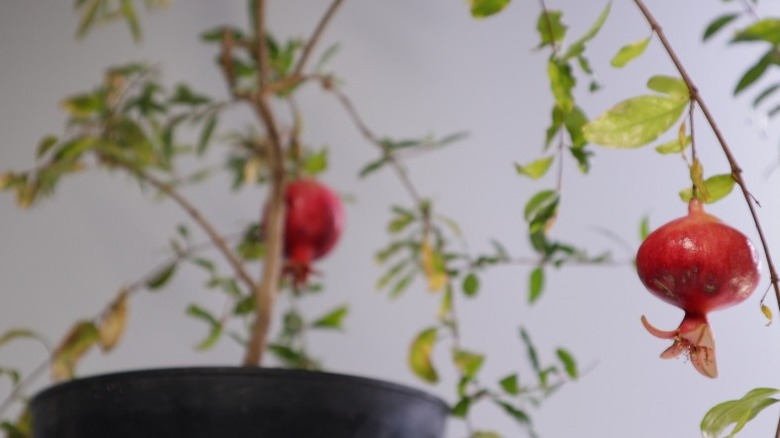How To Grow And Take Care Of Pomegranate Trees
Punica granatum, more commonly known as the pomegranate tree, holds significance in various religions and civilizations. As Literary Hub explains, pomegranates (along with the God of Death, the Goddess of Fertility, and her daughter Goddess Persephone) play a key role in the ancient Greek explanation for winter's scarcity and summer's abundance. The pomegranate's symbolism can be found across many cultures both ancient and modern. For example, in Judaism, there are supposed to be 613 seeds in each pomegranate — one for each mitzvah, Chabad explains.
Pomegranate trees are blessed with delicious rosy fruit, which is famed for its health benefits, Healthline notes. With their glossy green leaves and beautiful orange-red flowers, it's easy to see why the pomegranate has captured imaginations for over a millennia. It also helps that the pomegranate tree is fairly easy to grow and take care of, as long as you're in the correct warm climate that it enjoys. It is plagued by few pests, and once established, a pomegranate tree can deal with some degree of drought, cold, or extra moisture. It should be noted, however, that the longer it endures less-than-ideal conditions, the worse the effect on the fruit may be.
How to use pomegranate trees in garden
Minneopa Orchards points out that there is a wide range of sizes and shapes of pomegranate trees available. Pomegranates make popular bonsai trees and small ornamental bushes that can be kept as small as 3 feet tall. However, a full-grown, mature tree on a commercial farm might be as tall as 20 to 30 feet. Though they can be pruned into trees, pomegranates are actually better categorized as shrubs, so they can even be used to form
a dense, fruit-bearing hedge if planted closely together.
Green Harvest stresses that pomegranates enjoy full sunlight and can withstand more drought and direct light than many other fruit trees. Consider planting pomegranate somewhere that other trees might struggle with the heat, or use them to intentionally create shade for other plants on the north side of the tree. Their hardiness and many available varieties make pomegranate trees an enticing option for all different types of gardens and gardeners, as long as the overall climate is favorable.
How to grow pomegranate trees
To ensure that you know exactly what you're getting, Gardener's Path recommends growing pomegranate trees by propagation rather than from seed. Make sure the soil you're planting into is loose and well-draining. Pomegranates prefer loamy soil or a loam-sand mix. According to The Gluttonous Gardner, they will establish themselves quickest in soils that are slightly acidic.
Dig a hole that's twice as wide as the root ball and deep enough to just fully cover it. If you've bought a bare-root tree, remember to soak the roots in water for at least 30 minutes before planting, or up to three hours ahead of the action. Place the sapling into the prepared hole and refill the hole with soil and compost in and around the roots, pressing gently to avoid any large pockets of air. Mulch heavily around the base of the new tree, taking care to keep the mulch from touching the stem. Water very well at first, and make sure to maintain soil moisture for at least the first few months after planting. If you're planting several saplings to form a hedge, space the pomegranate shrubs 6 to 9 feet apart. If you're hoping to grow larger trees for fruit harvests, The Spruce recommended keeping them at least 15 feet apart.
How to care for pomegranate trees
Pomegranates require heat, well-draining soil, and direct sunlight to grow successfully. As Growing In The Garden notes, as long as you can keep them warm and give them a minimum of four to six hours of sunlight per day, then they are quite easy to maintain. Although pomegranates can withstand some drought, they thrive with regular, deep watering around once a week, notes Gardenerdy. Allow the soil enough time to fully dry out between waterings though, as they don't appreciate having wet feet! Adding some fertilizer to the soil might be necessary if your soil is particularly poor, but most gardeners simply spread well-rotted compost around the base of the tree in the spring, or just as the tree comes into leaf.
Pomegranate trees do require some pruning, as Gardening Tips explains. The suckers or new shoots that emerge from the roots in the summer are useful if you intend to create a hedge. If you intend to grow fruit, however, be sure to trim any suckers quickly, as they will divert energy away from producing the biggest, juiciest fruits possible. After the tree's first year, prune crossing shoots and branches so that there are only three to five shoots per branch. This will encourage more tree-like growth and ensure the branches don't snap from the weight of too many heavy fruits!
Pomegranate tree varieties
Pomegranates have been growing alongside humans for centuries and have adapted to gardens from Portugal to California. Therefore, there are many different varieties to choose from. As previously mentioned, the dwarf variety used for bonsai (Punica granatum var Nana) grows much smaller and is better suited to greenhouses and other indoor spaces. Nola.com confirms that it is a purely ornamental variety and anyone hoping for pomegranate fruits from their tree should consider some of these alternative cultivars. Utah State University's Yard and Garden Extension provides information on a number of pomegranate varieties:
- P. granatum "Balegal" produces large, pinkish fruit with dark flesh and sweet juice.
- P. granatum "Wonderful" was first grown in Florida, though most commercially-grown pomegranates in California are of this cultivar. These pomegranates are better for juicing rather than eating, due to the thicker skin, softer seeds, and excellent flavor.
- P. granatum "Early Wonderful" produces fruit that's ready "early," or roughly two weeks earlier than the "Wonderful" variety. With thinner-skinned fruit and higher production than the leading cultivar, this variety deserves consideration.
- P. granatum "Francis" is a Caribbean variety that's taken to the continental U.S. well and produces a very large amount of fruit.
- P. granatum "Utah Sweet" is a variety that doesn't produce fruit as large as other varieties, but the fruit that it does produce are sweeter, pinker, and with smaller seeds. Choose this option for the kind of fruit that impresses friends and family with flavor, rather than bulk.
Are pomegranate trees toxic?
A lot of scientific research has been done on the medical benefits of pomegranate trees, fruits, and extracts. It is well-known that the fruit and its juice are high in antioxidants. However, many medicinally beneficial plants can have adverse side effects if used incorrectly. According to one study published by ResearchGate, pomegranate plant extracts are generally considered safe, with diarrhea being the worst effect on some sensitive people after ingesting large amounts.
It is important to note that much smaller amounts of pomegranate peel or seeds can have a similar effect on dogs. The juice is fine — in fact, many of the same health benefits for humans are also true for dogs. But take care to avoid feeding them any of the white peel or seeds, as this can cause them significant digestive distress. Before you panic though, just remember that pomegranate isn't toxic to dogs, it is just the peel that can give them a bad stomachache, explains Hepper.
How to repot pomegranate trees
If you're growing pomegranate trees according to best practices, you'll likely have to repot it at least once. If you're growing in a container, the first two years require that it be at least 18 inches deep and wide, after which the tree will need to be moved to a larger container at least 24 inches in height and breadth, according to Harvest to Table.
Repotting should be done in winter when the tree is in its most dormant and least sensitive state. Pruning before repotting will make the tree easier to move, and more likely to survive the shock of being transplanted. Prepare the next location or new pot before attempting to do anything to the tree, as this will shorten the time the plant is out of the soil. This will require digging a hole that's at least twice as wide as the root spread, and lining the base with a layer of homemade organic compost or other fertilizer.
When the tree is dormant and its next location is fully prepared, you can begin to gently loosen the soil around its roots. Get the soil as wet as possible for this stage of the process, as the roots are less brittle when well hydrated. Carefully move the tree to its new home. Cover the roots with soil and compost, and top with mulch. Water the newly transplanted tree heavily and pay close attention to it for the next few months.
